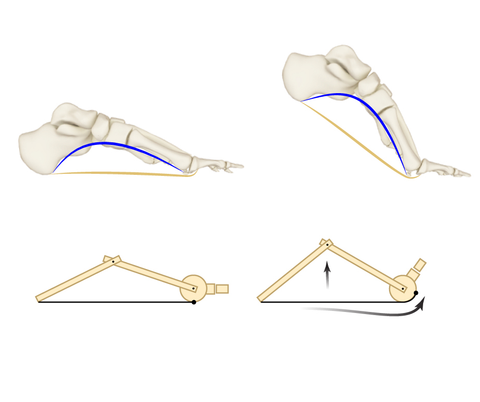Mobile toes are pivotal for full function | Balance & The Windlass Mechanism
Our feet didn’t evolve to be compressed. They are designed to spread, spring back and roll with the punches. Why do the majority of modern socks and shoes restrict our optimal and natural foot function?
I want to tell you a little about why you should spread them – your toes that is.
Be prepared for a little anatomy and physics but it’s well worth understanding the amazing mechanisms within our feet and the work they do.
The role of your feet and toes can be split into two crucial aspects, essential for running, walking and everything in between:
- To provide posture and balance
- Provide propulsion in running, jogging and walking
The toe are in contact with the ground for three quarters(1) on the stance phase of walking (when your foot is on contact with the ground) and play an important role in anchoring and transferring force. They become more and more crucial as your heel comes off the ground and the surface are of your load shifts to your forefoot and toes only as the windlass mechanism really comes into play here which helps in regulation of energy storage within the foot (2).
Your foot isn’t just a rigid lever either. It’s made up of 28 bones, connected together via 30 joints that are interconnected and controlled by over 100 ligaments, muscles and tendons. Your feet are made to be strong and mobile – it’s how they function best.
1. Posture and Balance
There are a lot of components which combine for good balance and within the foot, 2 stand out as the most significant:
- Plantar tactile sensitivity
- Toe plantarflexor strength
Tactile sensitivity
Plantar tactile sensitivity helps give you your ability to feel and react to tiny changes in the surface under your feet form pebbles to react to, do changes in ankles and surfaces.
It’s crucial for our hands and feet. It’s a bit like if you walked around a pitch black room and had to feel yourself around. Hands reaching out, walking around, feeling the contours and helping guide you.
Similar if you are our walking or running, it doesn’t have to be dark as if you are looking up ahead or around, you rely on the sensation in your feet to feel exactly what you are standing on so that you can react to it ASAP.
This is one of the reasons we are fans of toe socks vs conventional socks. Image feeling your way around that dark room or house with mittens on, vs gloves. You’re always going to be able to feel and grip better with gloves and hen your fingers are allowed to spread and feel better.
The same goes for your feet – your feet will have a better chance to feedback sensation and proprioceptive information to your brain, if your toes aren’t bound together.
Toe Plantar flexor strength
Toe plantarflexion is when you bend or curl your toes downward (plant them). Strength of these muscles is crucial for balance. Even when just standing upright, your toes and planted, preventing you falling onto your face.
Toe show how much they play a role, try standing on one leg and trial doing it with your toes up off the ground, compared to with your toes on the ground.
Was it a lot easier with your toes on the earth?? You might have also noticed how your toes spread and clench and shift weight from one side to the other to help maintain balance. The more they can move, the better.
Propulsion
The function of the foot can be simplified as: A complaint structure during mid stance and a stiff level during push-off.
Going from initial foot strike into mid phase where the length of our foot is in contact with the ground, requires our foot to be complaint. But then, as our heel comes off the ground and we want to release the wound up energy and propel ourselves forward, stiffness is more important. The stiffness means we don’t lose much of the energy and power when pushing off, it’s transferred through the ground and we move forward, economically.
How does our foot have these dual roles, shifting from compliant to stiff?
The key is the link between our plantar fascia and our big toe - let's break it down to show you what an awesome mechanism it is.
Your Plantar Fascia is a very strong band of connective tissue. it doesn't contract or shorten but acts as a lever. Because it runs from your heel, all the way to your big toe, movement of your big toe up or toe, changes the tension of the plantar fascia.

The Windlass Mechanism and gait
When our foot is flat on the ground, the windlass mechanism isn't taught and this allows natural and essential movement of your arch.
Now as we move towards the end of stance phase, our heel strays coming off the ground. Even through our big toe stays down, as our heel comes up, our big toe is effectively pushes upwards, increasing the tension on your plantar fascia. By tensioning this up, it draws your heel and the ball of your foot together and raises your arch up!
Pretty awesome! This creates a more rigid lever to push off and means less energy is lost when pushing off.
Summary
Your foot and toes and essential for balance, control, proprioception and last but not least, propulsion and arch rigidity. Keeping your foot functioning well really helps and allowing your toes, particularly your big toes, to move well and stay aligned ahead is key.
#ToeSocksOrNoSocks
Subscribe to keep up to date and get the latest blog posts educating you all about your feet and tips to improve resilience, strength and mobility as well as trail reviews.


